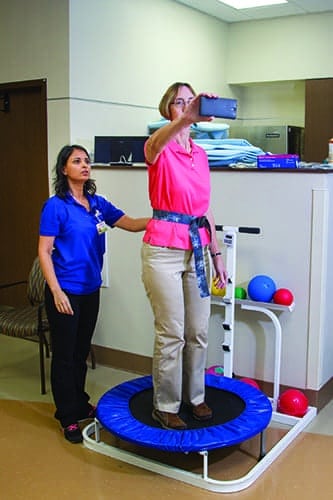
Dynamic balance is addressed by using a foam block/trampoline, fall prevention strategies, and extensive education and training on activities of daily living.
by Saloni Agarwal, PT
The vestibular system functions as a detector of body position in space. It maintains safe posture by facilitating static and dynamic balance reactions. This complex system works closely with the cerebellum and other areas of the brain to improve balance, vision, safety, and functional mobility.
The human vestibular system is situated deep within the temporal bone, in a space called the “labyrinth.” The vestibular system includes three semicircular canals and otolith organs which includes the utricle and the saccule. Semicircular canals measure rotational/angular movements of the head, whereas otolith organs measure linear movements. The canals are filled with fluid called “endolymph,” which moves freely within each canal in response to rotational head movements. Otolith organs respond to linear acceleration to the pull of gravity. Calcium carbonate crystals are implanted on the gel-like structure within the saccule and utricle.
The vestibular system has a connection with higher brain centers and the cerebellum, resulting in the body’s awareness in the environment. Agrawal et al suggest that approximately 35% of individuals age 40 years or older in the total adult population of the United States have suffered from symptoms of vestibular dysfunction, including dizziness, imbalance, and nystagmus, at some point of their lives requiring a medical and rehabilitation approach.1
Disruptions in the Balance System
The brain integrates balance information by gathering feedback through three sensory systems: vision, vestibular system, and proprioception (sensory receptors in joints and muscles). A healthy balance system has the ability to accept and process mixed signals from the three aforementioned systems while maintaining equilibrium and movement execution, such as the ability to walk from a hardwood surface to carpet without losing balance or watching a high-speed train pass while standing at a subway station without feeling dizzy. Disruption in the balance system result in dizziness (light-headedness or disequilibrium), vertigo (spinning or rotational movement of one’s surroundings, even when it is not), spatial disorientation (inability to identify one’s own body position in space), imbalance, and falls. Occasionally, the sensation of dizziness and spinning may be accompanied by double vision and/or abnormal jittery eye movements called nystagmus. Visual disturbances cause difficulty with one’s ability to read captions or read road signs while walking or driving. Inability to perform routine tasks without being dizzy and with constant fear of falling is noted to result in anxiety, poor quality of life, and detachment from the community.
Dizziness and vertigo could be linked to age-related changes to bone health; muscle strength; joint mobility; hearing loss secondary to certain viral and bacterial infections; proprioceptive disorders caused by peripheral neuropathy; central nervous system disorders such as tumor of vestibular nerve, brainstem, or cerebellum; stroke; whiplash injuries and migraine; brain injury; or cardiovascular diseases such as orthostatic hypotension.2
In addition, causes directly related to the vestibular system include abnormality in composition, quantity or pressure of endolymph, superior canal dehiscence, damage to tympanic membrane, drug/chemical toxicity caused by prolonged use of antivert medication, antibiotics, abnormal skin growth in the middle ear extending to the inner ear, and benign paroxysmal positional vertigo (BPPV). Signs and symptoms of vertigo may be experienced after being on a cruise, or from sudden changes in air pressure experienced during flight.
Fear of falling causes an individual to limit routine mobility, leading to progressive weakness and thus, increased risk of falling. Severity of symptoms could be amplified if multiple systems are involved.3 For instance, an elderly person with age-related hearing loss and visual impairment may not have profound impact on balance control and dizziness until diagnosed with diabetic neuropathy (reduced sensation in feet). The individual may experience dizziness every time body position is altered, such as rolling side to side, sitting up from lying, standing up, or walking down the aisle. The sensation of dizziness or hallucination of motion may last up to several days after the initial attack of vertigo.
Assessment, Diagnosis, and Treatment Technologies
A thorough assessment of symptoms by a clinician, as well as a careful detailed medical history, is vital for accurate diagnosis. After confirming the diagnosis, appropriate medical management is followed by physical therapy (PT) referral. PTs use a series of standardized tests including oculomotor testing to assess eye movements; vestibulo-occular reflex test and head thrust test to assess coordination between head and eye movements; and Dix Hall Pike test to assesses pathology of semicircular canals, and to obtain baseline scores on balance and gait assessments.4
A neuro-otologist, neurologist, and audiologist are consulted for vestibular disorders. Some of the tests performed by physicians are electro-video nystagmography (VNG), which monitors and measures eye movements to assess signs of vestibular dysfunction, and vestibular-evoked myogenic potentials to assess the integrity of vestibular organs and nerves.3 Other tests may also include hearing tests, vision tests, computerized tomography scan, and magnetic resonance imaging.
Rotational chair test:
This test helps to rule out bilateral vestibular hypo function (reduced vestibular feedback). The patient is seated in the chair and the chair is rotated at a predetermined velocity, or the chair is oscillated left to right at varying frequencies. The rotational movement causes the endolymph to flow, resulting in nystagmus. If the vestibular system has been compromised, the nystagmus will still be seen. However, magnitude will vary depending on the extent of the lesion.3
Video goggles (infrared goggles):
Also known as Frenzel lenses, they are used to measure the degree of abnormal eye movements as well as the direction of eye movements. They are also used to assess treatment effectiveness. Theses lenses are connected to a computer screen, enabling the clinician to analyze quality of eye movements.
Computerized Dynamic Posturography:
The use of computerized dynamic posturography allows the clinician to measure the effectiveness of three sensory inputs (vision, vestibular, and proprioception) at the time of evaluation, during the course of treatment, and at the end of rehab. It facilitates relearning of normal limits of stability, center of gravity, and base of support by introducing therapist-guided static and dynamic tasks.
Medical management is aimed at subsiding symptoms of vertigo and dizziness, and allows patients to tolerate various therapeutic interventions. Some commonly prescribed vestibular suppressants are meclizine, lorazepam, clonazepam, and diazepam.
PT management for BPPV involves a specialized approach in which the symptoms are treated with strategies, known as canalith repositioning maneuvers, to reposition dislodged crystals. BPPV presents with abnormal eye movements (nystagmus) with specific directional change in head position. The direction, speed, duration, and torsional nature of nystagmus helps to identify which canal is involved.

A thorough assessment of symptoms by a clinician, as well
as a careful detailed medical history, is vital for establishing an accurate diagnosis.
Protocol and Practice
Vestibular rehabilitation involves systematic progression of exercise protocols which reduce or eliminate vertigo, improve balance and equilibrium, and coordinate head and eye movements. Successful outcomes can be achieved by a customized vestibular rehabilitation therapy approach (habituation, adaptation, and substitution).5 Adaptation and habituation exercises involve introduction of symptom-provoking movements at progressively increasing frequencies and varying head positions to reduce error signals from the brain, and hallucination of motion, respectively.5 For example, have a patient stand on a foam block in front of the light board, while they track and follow the lit targets. Substitution strategies work by strengthening the weak (hypo-functioning) sensory system and by reducing dependence on existing ones.5 For instance, a patient, standing on trampoline, while marching with eyes tracking an optometer, is forced to engage the vestibular system while the somatosensory system is challenged. A patient-specific home exercise program is established by the treating therapist to improve efficiency of rehabilitation, promote safety during daily routine tasks, reduce risk of falls, and increase functional gain.
Balance and disequilibrium symptoms are addressed by incorporating strengthening, conditioning, and balance training. Dynamic balance is addressed by using foam block/trampoline, fall prevention strategies, and extensive education and training on activities of daily living. Rehab is aimed at improving eye movements, balance, postural stability, and muscle coordination in orthopedic, as well as neurological diagnosis. A balance platform offers 12 levels of control (level 12 is the most stable, level 1 is the most unstable) to enable the therapist to challenge the patient’s balance recovery abilities by facilitating static and dynamic balance, proprioceptive training, balance stabilization exercises, and weight shifting exercises.
A Light Board is piece of visual-motor training equipment that evaluates and trains visual scanning, cognitive processing, reaction time, and motor planning abilities while reinforcing postural stability, and static and dynamic balance. Both types of equipment provide an analysis of the patient’s performance at the end of each session.
Neurological conditions such as multiple sclerosis, stroke, Parkinson’s disease, peripheral neuropathy, tumor, and trauma, and infections such as meningitis, encephalitis, Lyme’s disease, and syphilis, commonly result in gait and balance disturbances, vestibular ataxia—ie, loss of balance, jittery eye movements, dizziness, nausea, and vomiting. Balance deficits in people with MS may or may not be associated with vertigo, and the symptoms rather depend on the region of the brain that is damaged, such as the cerebellum, the type of lesion, the extent of nerve damage, and loss or increase of muscle tone.6
Thirty-three randomized control trials assessed the effectiveness of PT or no PT on 1,518 patients with Parkinson’s disease. The trials, published by Cochrane, revealed significant improvement in step length and walking speed but no change in risk of falls.6 In a 2009 Cochrane review, three randomized controlled trials showed improvement in muscle strength with exercises but no change in disability for patients suffering from progressive supranuclear palsy; hence, the patients would need to be trained to rely on visual feedback during standing activities.6 Patients with degenerative conditions such as supra nuclear palsy, spinocerebellar ataxia, Parkinson’s disease, and large fiber peripheral neuropathy, demonstrate cognitive decline, retropulsion, loss of proprioception, and vibration sense.6
To summarize, repositioning maneuvers are found to be effective in BPPV only. Inclusion or exclusion of various vestibular rehab approaches will depend on symptoms presented by the patient and functional deficits assessed by a clinician, either in an outpatient, home health, or subacute rehabilitation setting. RM
Saloni Agarwal, PT, is certified in vestibular rehabilitation, and works with patients at HealthSouth Rehabilitation Hospital of Ocala to rehabilitate vestibular disorders through patient-specific routines that are determined by an in-depth assessment. She earned her bachelor’s degree in Physical Therapy from Srinivas College of Physiotherapy in India and her master’s degree in Healthcare Administration from National University in California. For more information, contact [email protected].
References
1. Agrawal Y, Carey JP, Della Santina CC, Schubert MC, Minor LB. Disorders of balance and vestibular function in US adults: data from the National Health and Nutrition Examination Survey, 2001–2004. Arch Intern Med. 2009;169(10):938–944.
2. King J, Buckner S. Causes of Dizziness. Vestibular Disorders Association. http://vestibular.org/sites/default/files/page_files/Documents/Causes%20of%20Dizziness.pdf. Accessed November 1, 2016.
3. Shupert C, Horak F. Balance and Falls in the Older Adult. Vestibular Disorders Association. https://vestibular.org/sites/default/files/page_files/Documents/Balance%20and%20Falls%20in%20the%20Older%20Adult.pdf. Published 2016. Accessed November 1, 2016.
4. Herdman SJ, Clendaniel RA. Vestibular Rehabilitation. 4th Ed. Philadelphia, PA: F.A. Davis Company; 2014.
5. Gans RE. Vestibular rehabilitation therapy: Diagnosis based strategies. The American Institute of Balance. http://blog.dizzy.com/wp-content/uploads/2015/11/ENT-Audiology-News-_Gans-Rehabilitation.pdf. Published November 18, 2015. Accessed November 3, 2016.
6. Tusa R. Non-vestibular Dizziness and Imbalance. In: Herdman SJ, Clendaniel RJ. Vestibular Rehabilitation. 4th ed. Philadelphia, PA: F. A. Davis Company; 2014:559–560.





It’s good to know that a thorough assessment is necessary for vestibular balance rehabilitation. My mom has been telling me about how she’s been having trouble staying up straight recently. I’ll share this information with her so that she can look into her options for professionals who can help her with this.
Hello Tyson: I’m glad to hear that this information was useful to you. Best of luck to your mother on her journey toward recovery.
—Ed.
Proud of you saloni agarwal, doing great job in vestibular rehabilitation and great article and i thoroughly enjoyed.keep it up.